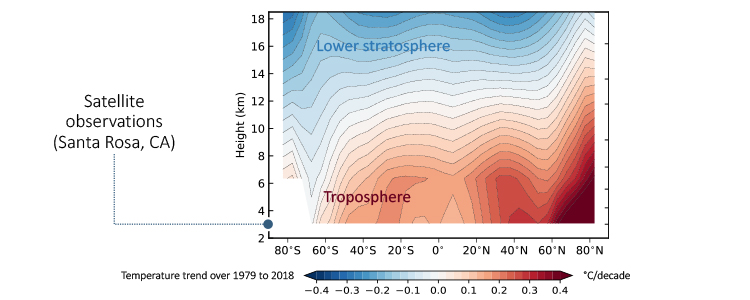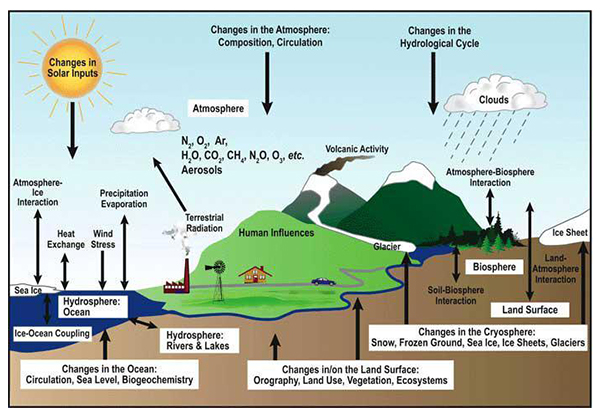I love mystery stories. I grew up on a steady diet of Sherlock Holmes and Ellery Queen. Mysteries and puzzles are part of the reason I was drawn to the field of climate science. One of the ultimate mysteries is figuring out why Earth’s climate changed over the past century. Climate change is like Agatha Christie’s Murder on the Orient Express—many different suspects are implicated. Human-caused changes in levels of heat-trapping greenhouse gases. Deforestation. Natural fluctuations in the Sun’s energy output. Volcanic activity. Internal cycles in the climate system. The real scientific challenge is to reliably quantify the degree of culpability of each suspect.
In evaluating how well a mystery novel has been crafted, it’s important to look at the consistency of the plot. A discerning reader might ask whether the internal logic rings true and the individual story lines are neatly woven together.
We can ask a similar question about the climate system. Is it telling us an internally consistent story about the causes of recent climate changes? The answer is a resounding “yes.” Over the last century, the Earth’s oceans and land surface warmed. Most glaciers retreated. The Greenland Ice Sheet lost some of its mass. Global-mean sea level rose. The atmosphere moistened. Rainfall and atmospheric circulation patterns shifted. Snow and sea-ice extent decreased in the Northern Hemisphere. Heat waves became more intense, longer lasting, and more frequent. Records for extreme heat were set more often than records for extreme cold. Even climatic metronomes like the daily and seasonal temperature cycles began to beat a little differently.
Our best scientific understanding is that all of these changes are consistent with the expected effects of fossil fuel burning. They cannot be explained by natural causes alone.
How do we know this? Let’s go back to the mystery story analogy. Fingerprints are unique markers that can link a suspect to the scene of a crime. Studies of the causes of climate change also rely on unique markers. The basic idea is that different influences on climate have different characteristic signatures in climate records. Human-caused increases in greenhouse gases, for example, don’t have the same climatic loops, whorls, and arches as purely natural changes in the Sun’s energy output. Patterns encode rich streams of information.
Until the 1980s, climate scientists tried to separate human and natural influences on climate by examining a single piece of evidence—the average temperature of Earth’s land and ocean surface. Then-available estimates of global-mean surface temperature suggested that Earth had warmed over the 20th century. This warming was judged to be unusually large relative to estimates of natural climatic variability. But global-mean temperature was a relatively blunt diagnostic; it did not provide definitive proof that human activities were responsible for most of the observed warming.
The real breakthrough happened in the late 1980s. That was when scientists started to look at more than the average temperature of the planet’s surface. These early pioneers harnessed the power of pattern recognition techniques to disentangle human and natural influences on the climate system.
They sliced and diced complex four-dimensional climate data sets horizontally, vertically, and in time. They interrogated latitude-longitude maps and sections through the full vertical extent of the atmosphere and oceans. They compared climate changes in winter and in summer. They used a mathematical tool called Fourier analysis to decompose climate data into wave forms, unlocking information about the characteristic time stamps of the sunspot cycle, and of natural oscillatory phenomena like El Niños and La Niñas.
These pattern studies were enabled by several key developments. One development was the capability of observing Earth’s climate from space. With the launch of the TIROS-1 weather satellite in 1960, the view of our planet’s atmosphere and oceans shifted from the local and regional to the global. In video game terms, humanity “leveled up.” We reached a new stage of awareness of our changing climate.
From space, scientists made measurements across most of the electromagnetic spectrum, utilizing a variety of wavelengths to probe temperature, rainfall, ocean color, fluxes of energy at the top of the atmosphere, sea-ice extent, wind speed, the water content of clouds, and dozens of other climate variables. They monitored changing atmospheric levels of carbon dioxide, ozone, particulate pollution, and volcanic aerosols. They tracked hurricanes and typhoons, observed massive phytoplankton blooms, watched wind-borne dust from the Sahara reach the Caribbean, and followed the global dispersion of volcanic aerosol from the 1991 eruption of Mt. Pinatubo. They witnessed the break-up of the Larsen-B ice shelf, the growth of a garbage patch in the North Pacific Gyre, deforestation of the Amazon and Indonesia, and oil fires in Kuwait. The exquisite beauty of Earth’s climatic life-support system was made visible, along with its fragility.

Figure 1: Satellite measurements of atmospheric temperature change from the Remote Sensing Systems research group based in Santa Rosa, California (http://www.remss.com/). Results are linear trends in temperature, in degrees Celsius per decade, over the 40-year satellite record (1979 to 2018). Trends are a function of latitude and the height in kilometers above the Earth's surface. Trends are averages at all available locations along each band of latitude, and are plotted for three layers of the atmosphere (the lower troposphere, the mid- to upper troposphere, and the lower stratosphere). The figure shows pronounced warming of the troposphere and cooling of the lower stratosphere. This "fingerprint" of atmospheric temperature change is consistent with human effects on climate, but is inconsistent with claims that all climate change since in 1979 is due to purely natural causes. Source: updated from Santer, B.D., J. Painter, C. Bonfils, C. Mears, S. Solomon, T.M.L. Wigley, P.J. Gleckler, G.A. Schmidt, C. Doutriaux, N.P. Gillett, K.E. Taylor, P.W. Thorne, and F.J. Wentz, 2013: Human and natural influences on the changing thermal structure of the atmosphere. Proceedings of the National Academy of Sciences, 110, 17235-17240, doi:10.1073/pnas.1305332110
The second major development in unraveling the mysteries of climate change was the rise of computer modeling of the climate system. In the real world, multiple human and natural influences on the climate system are varying simultaneously. We don’t have the luxury of being able to hold the Sun’s energy output constant for decades or centuries. But in the virtual lab of a climate model, scientists can change one influence at a time. They can isolate the unique climatic fingerprints of the Sun, volcanic activity, stratospheric ozone, and greenhouse gases. They can estimate these fingerprints with simple and complex models. They can determine if the fingerprints are robust and interpretable in terms of well-understood physical mechanisms. And finally, they can search for the model-predicted fingerprint patterns in hard data.

Figure 2: Some of the components and processes in a typical computer model of the climate system. Image rights: Le Treut, H., R. Somerville, U. Cubasch, Y. Ding, C. Mauritzen, A. Mokssit, T. Peterson and M. Prather, 2007: Historical Overview of Climate Change. In: Climate Change 2007: The Physical Science Basis. Contribution of Working Group I to the Fourth Assessment Report of the Intergovernmental Panel on Climate Change [Solomon, S., D. Qin, M. Manning, Z. Chen, M. Marquis, K.B. Averyt, M. Tignor and H.L. Miller (eds.)]. Cambridge University Press, Cambridge, United Kingdom and New York, NY, USA.
By exploiting these model simulations, satellite measurements, and many other observational data sources, scientists found that human fingerprints on climate are ubiquitous. Let me give you one example. In 1967, Suki Manabe and Richard Wetherald—both scientists at the Geophysical Fluid Dynamics Lab in Princeton —used an early computer model of the atmosphere to increase atmospheric CO2 levels from 150 to 300 to 600 parts per million (1). They showed that human-caused increases in greenhouse gases should produce sustained warming of the lower atmosphere and cooling of the upper atmosphere. Decades later, in our own research at Lawrence Livermore National Laboratory, we detected this curious pattern of large-scale atmospheric warming and cooling, first in weather balloon temperature measurements, and later in satellite temperatures inferred from the microwave emissions of oxygen molecules. No known natural phenomena can produce this fingerprint pattern.
Such fingerprint evidence contributed to an historic 1996 conclusion of the Intergovernmental Panel on Climate Change: “the balance of evidence suggests a discernible human influence on global climate” (2). Critics of the 1996 finding argued that the evidence was too preliminary, and could be overturned by the availability of better observations, better models, and better pattern recognition methods.
Instead of being overturned, the evidence for a “discernible human influence on global climate” strengthened since 1996. We now have better and longer observational records for hundreds of different climate variables. Models improved dramatically in terms of the fidelity with which they represent today’s average climate, the seasonal cycles of temperature and rainfall, the patterns and timescales of natural variability, and key physical processes involving clouds and the ocean. Statisticians introduced more rigorous fingerprint methods. As a result of these and many other advances, the most recent report of the Intergovernmental Panel on Climate Change, published in 2013, reached a far more definitive finding than the cautious 1996 “discernible human influence” statement. The 2013 report used information from many different sources to estimate the size of the human effect on climate, concluding that: “It is extremely likely that human influence has been the dominant cause of the observed warming since the mid-20th century” (3).
Despite this evolution in scientific understanding, there will always be uncertainties in climate models, in observations, and in our physical understanding of the climate system. The difficult problem that confronts us – as a nation, and as citizens of this planet—is how to act in the face of both remaining scientific uncertainties and the overwhelming scientific evidence that our actions are altering global climate. We should be very clear about one point. The decisions we reach today will influence the climate that future generations inherit.
In addition to being a mystery buff, I’m also a rock climber. I can recall at least one occasion on which I had to stand on a friend’s shoulders to reach elusive handholds that I couldn’t quite grasp on my own. Science is like that, too. There are pieces of the climate puzzle that you cannot hope to reach without standing on the metaphorical shoulders of the body of work others have assembled. The fingerprint
work that I’ve been involved with would not have been possible without important contributions from colleagues at Livermore and around the world. It’s been a real privilege to share this scientific journey with them.
Ben Santer is an atmospheric scientist with the Program for Climate Model Diagnosis and Intercomparison at Lawrence Livermore National Laboratory. He is the 2019 recipient of the Sigma Xi William Procter Prize for Scientific Achievement and will be a plenary speaker at the Society's 2019 Annual Meeting and Student Research Conference on November 16 in Madison, Wisconsin.
(1) Current levels of atmospheric CO2 are at roughly 415 parts per million (ppm). Before the start of large-scale fossil fuel burning, levels of atmospheric CO2 were at approximately 260 to 270 pm.
(2) Santer, B.D., T.M.L. Wigley, T.P. Barnett, and E. Anyamba, 1996: Detection of Climate Change, and Attribution of Causes, in Climate Change 1995: The Science of Climate Change. Contribution of Working Group I to the Second Assessment Report of the Intergovernmental Panel on Climate Change. Edited by J.T. Houghton, L.G. Meira Filho, B.A. Callander, N. Harris, A. Kattenberg and K. Maskell, Cambridge University Press, Cambridge, 407-443.
(3) Bindoff, N.L., K.M. AchutaRao, M.R. Allen, N. Gillett, D. Gutzler, K. Hansingo, G. Hegerl, Y. Hu, S. Jain, I.I. Mokhov, J. Overland, J. Perlwitz, R. Sebbari, and X. Zhan, 2013: Detection and Attribution of Climate Change: from Global to Regional, in Climate Change 2013: The Physical Science Basis. Contribution of Working Group I to the Fifth Assessment Report of the Intergovernmental Panel on Climate Change. Edited by T.F. Stocker, D. Qin, G.-K. Plattner, M. Tignor, S.K. Allen, J. Boschung, A. Nauels, Y. Xia, V. Bex, and P.M. Midgley, Cambridge University Press, Cambridge, 867-952.